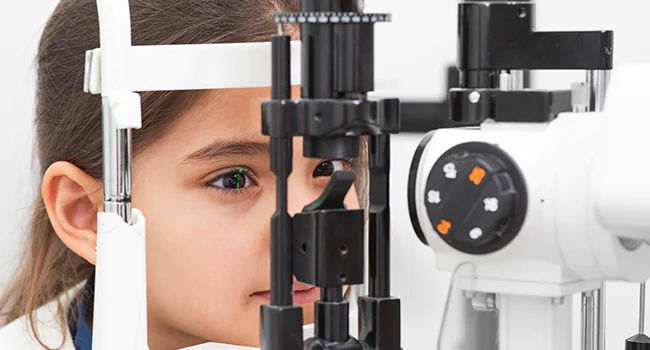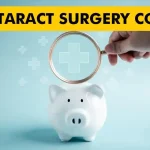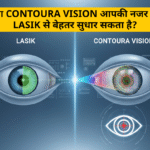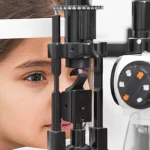Amblyopia, also known as lazy eye, is improper or abnormal visual development (acuity) in one or both eyes. It is the most common cause of vision loss in kids. Amblyopia develops when there is an anomaly between the functioning of the eyes and a specific part of the brain, which understands the visual inputs.
Nerves take signals from both the eyes to the brain, but if there is a huge difference between the vision of both eyes, then the brain reads signals only from the stronger eye and ignores the inputs from the weaker one. Ultimately, the brain relies more on the stronger eye and the vision of the weaker eye gets worse with time, leading to amblyopia.
As it usually happens during the early days of childhood when a kid’s vision develops, timely diagnosis and treatment are absolutely critical in such cases.
What Causes Amblyopia (Lazy Eye)?
Most doctors don’t know the actual cause of amblyopia but some eye conditions also lead to amblyopia.
Refractive Errors:
Despite a perfect eye alignment, vision problems like nearsightedness, farsightedness, and astigmatism (distorted or blurred vision) can cause refractive errors leading to amblyopia.
Strabismus:
It is caused by poorly aligned eyes. In this case, both eyes don’t line up and one could turn in and the other one can turn out. This causes double vision and to avoid it, the brain ignores the input from the eye which is not aligned.
Cataract:
Some kids have congenital cataract which causes cloudiness or blurry vision in the eye lens. It hinders the proper vision development and causes amblyopia.
Amblyopia Symptoms, Diagnosis & Treatment
Although amblyopia symptoms are hard to notice without a proper eye examination, some of them include:
- Inability to see clearly
- Poor perception of depth or distance of an object
- Frequent squinting or shutting of the eye
- Difficulty in catching and throwing objects
- Tilting of head on one side
- Droopy eyelid
Early diagnosis is very important in case of amblyopia to avoid improper development of the vision. Since these symptoms are hard to identify, diagnosis can be done through vision screening or test. Once amblyopia is diagnosed, the treatment can include the following:
Using glasses or contacts:
In cases of refractive errors, doctors usually recommend glasses or contacts and train the brain to re-learn the vision input from the weaker eye. In this process, the weaker eye vision is improved using glasses, and when the nerves send a clear image to the brain, it allows them to develop a normal vision.
Eye Patches:
In this case, doctors suggest wearing an eye patch on the stronger eye which forces the brain to use the weaker eye, and with time, the weaker eye’s vision gets better.
Eye Drops:
To treat amblyopia, atropine eye drops are used to temporarily blur the vision of the stronger eye which again forces the brain to use the other eye.
Surgery:
In the case of cataracts, droopy eyelid, and strabismus is causing amblyopia surgery is required to improve eye vision and alignment.
Is Amblyopia treatment also possible for adults?
Yes, it is treatable! For decades, doctors believed that amblyopia in adults can’t be treated and even if it is treated with successful vision improvement, the treatment has to be continued in order to maintain the vision. Today, with a lot of research data and the latest technologies we can say that there is no age limit for the treatment, and adults can also be successfully treated.
However, we can’t deny that the treatment for adults is complicated and needs a lot of contribution, time & effort from the doctor and the patient. So let’s see a few ways how it can be treated:
- Amblyopia hampers the binocular vision of a person which leads to functional vision problems. This can be treated using special glasses or contact lenses which uses latest techniques to involve both eyes together (MFBF)
- Virtual reality based vivid vision system is increasingly being used for the treatment of amblyopia in which, a headset or goggles with small video screens are provided to the patient and the signal strength of the visual image is increased for the weaker & vice versa to make it easier for both eyes to work together
- Traditional methods such as patching is also used to stimulate the eye vision
How Centre for Sight can help?
Centre for Sight provides specialized eye care, with highly experienced eye specialists and advanced eye treatment technology. For amblyopia treatment in kids, we have experts to conduct thorough diagnoses and provide an honest clinical opinion for the best treatment. In order to treat amblyopia in adults, we use our years of experience, knowledge, advanced science, and the latest technologies for successful results.
Article: Understanding Lazy Eye Treatment for Adults
Author: CFS Editorial Team | Dec 02 2020 | UPDATED 04:00 IST
*The views expressed here are solely those of the author in his private capacity and do not in any way represent the views of Centre for Sight.





